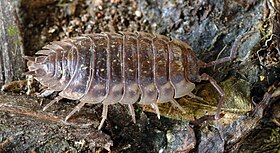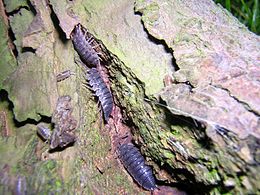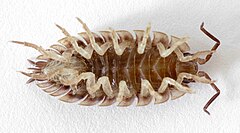Lobsters
| Lobsters | ||||||||||||
|---|---|---|---|---|---|---|---|---|---|---|---|---|

Wall wood louse ( Oniscus asellus ) |
||||||||||||
| Systematics | ||||||||||||
|
||||||||||||
| Scientific name | ||||||||||||
| Oniscidea | ||||||||||||
| Latreille , 1802 |
The landlice (Oniscidea) are a suborder of the woodlice (Isopoda) living on land . They are the only permanent crustaceans living on land , and unlike land hermit crabs and other temporarily onshore cancer groups, they can reproduce outside of the water. Worldwide there are more than 3500 different species of land louse, which are distributed among several families. Around 50 species are native to Germany.
anatomy
The habitus of the isopods corresponds to the other groups within the isopods, the characteristic anatomical features of the isopods are rather inconspicuous. These include above all the first antennae, which have been reduced to small stumps, as well as the missing palps on the mandibles . The first two pairs of legs in the abdomen ( pleopods ) are transformed into pistil-like mating organs in the males.
Most land lice are between two and 20 millimeters long and are flattened dorsoventrally and long- oval. The body consists of clearly recognizable individual segments, each of which has a wide back shield. A head- chest section ( cephalothorax ), a chest section ( peraeon ) and an abdomen ( abdomen ) can be recognized as body sections from below .
The head is fused with the first breast section and, in addition to the compound eyes, also has two pairs of antennae, of which the first pair is very small and the second is usually very large. On the underside of the head are the mouthparts , which, like all higher crustaceans, consist of the mandibles and two pairs of maxillae .
The peraeon carries the seven pairs of legs of the animals (peraeopods), which are each rod-like and all of the same build. In contrast to those of the cephalothorax, the individual breast segments can move freely against each other. The last section is the abdomen, which also bears extremities ( pleopods ). However, these are no longer designed as pairs of legs, but form flat plates that lie on the underside of the animals and cover the gills or, in more developed species, the respiratory surfaces (see below). The last segment ends in a so-called telson , which is flanked on both sides by uropods , which together with the telson form a tail fan and serve as tactile organs.
Physiological adaptations to the terrestrial way of life
There are different degrees of adaptation to rural life in land lice. Original species like the beach louse still lead an almost amphibious life and are gill breathers . More highly developed species have already developed tracheal organs .
These species have branched invaginations on the exopodites of the pleopods , where air can penetrate and oxygen can be absorbed by the blood. These organs can be recognized very well by the fact that they are colored white by the air they contain (white bodies). In spite of this, gill breathing is still preserved in these already specialized species, namely on the pleopods, the wood louse only has gill breathing. This is why woodlice like moist habitats, because the gills must always be covered by a thin film of water. To do this, they use a water management system made up of open longitudinal channels all over the body, especially on the stomach. However, this guidance system is not suitable for drinking water intake, so land lice drink water orally.
The water supply system serves both for excretion and to keep the gills moist. The fluid circulating in the system is the secretion of the maxillary glands, which contains ammonia as an excretion product , which can be released into the air through evaporation . The ammonia-free liquid then reaches the gills and the excess can be taken up again through the anus.
It is interesting to note that a special gill fauna has developed in the gill chambers of the land lice, which are completely sealed off from the outside world. Microscopic, water-dwelling organisms can use this zoo hotelma as a habitat. The biocenosis consists for example of nematodes (Nematoda) the genus Matthesonema , rotifers of the genus Mniobia and various free-floating or fixed ciliates , z. B. of the genus Ballodora . The ancestral forms of these animals come partly from the sea and partly from the soil of terrestrial habitats. In order to colonize the new cuticula after molting as well as the young animals, the animals actively swim out of the old cuticula during molting, the sessile ciliate animals form swarmers.
Way of life
The cuticle of the landlice contains chitin , but has no wax layer. In a dry atmosphere, water losses through evaporation are therefore extremely high. This is why the animals are nocturnal, especially in summer, and hide under stones, bark or in the vegetation during the day. In spring and late autumn, daytime activity increases again significantly. This often results in large groups of animals ( aggregations ) being formed. Woodlice very seldom dig into the ground, for example for wintering and some species such as the ragweed also for moulting , otherwise they remain in the litter layer of the ground.
Especially Roll isopods and in even greater extent species such as the desert Assel ( Hemilepistus reaumuri ) have adapted by their fully migrate to Tracheenatmung and other adaptations to drier habitats.
nutrition
Common isopods, together with springtails (Collembola), various mites and millipedes, belong to the typical fauna of the soil surface and play an important role as destructive organic material, so they are of great ecological importance as decomposers and humus formers.
They feed primarily on decaying plant material, especially fallen leaves and wood, but also eat algae, fungal hyphae, carcasses of insects, feces and spider eggs. Your own feces are also absorbed several times ( coprophagia ), since they cannot be completely broken down with a simple passage through the intestine due to the high proportion of cellulose and lignin . Due to the additional absorption of sand and other mineral components of the soil, the excrement forms clay-humus complexes , which are important as soil components, as with earthworms .
While they play a rather insignificant role in soil formation in Central Europe compared with earthworms, they are often the only litter decomposers in arid regions. In the desert regions of North Africa, for example, there is the desert isopod, which in large parts is the only soil animal species with this ecological one Function.
Reproduction
Woodlice are, with a few exceptions, separate sexes. The animals reach sexual maturity in the first to third year of life, depending on the species.
The mating takes place without mating rituals or the like in the habitat of the animals. After mating, the females shed their skin and develop a brood space between the hips of their legs, called a marsupium , and lay their eggs in it (10–70 in the wood louse, 20–160 in the roll louse). The egg-bearing females secrete a liquid in the marsupium in which the eggs can develop like in a "portable aquarium". The young hatch after 40 to 50 days and are then released. The armor, which was still very thin at this point, is replaced in a double skin and then hardens.
The woodlice can only grow when it sheds its skin . The shell bursts open in the middle of the animal and the rear part of the shell is stripped off by pumping movements. Then the front part is pushed off by further contractions. This can take a few hours to two days. The shell is often eaten afterwards because it contains important nutrients. Like other crabs, woodlice shed their skin for life.
Predators and diseases
Spiders of the genus Dysdera such as the great woodlice hunter specialize in woodlice as food. The larvae of woodlice flies live as parasitoids in woodlice and feed on their hemolymph and organs, whereby the vital organs are only consumed at the end. After pupation, they leave the now dead host as adult flies. Furthermore, shrews, hedgehogs, the little owl, toads, frogs, blindworms, raven-winged beetles, ground beetles, wolf spiders, harvestmen and centipedes have been identified as predators, but none of these animals are dependent on landlice as a source of food, but only eat them occasionally. There is also a deadly disease, the iridovirus. Infested woodlice are blue or purple in color and die after a while.
To protect against predators, some landlice, such as. B. Roll representatives of the families Armadillidae, Cylisticidae or Armadillidiidae into a ball. Other species can secrete a greasy secretion, but this does not keep enemies off reliably.
Distribution and habitats
Wood lice are distributed worldwide in all terrestrial habitats, the only exception being the polar regions. The greatest number of species is found in the tropics and subtropics , especially in habitats with high humidity. On the other hand, very few species live in particularly dry areas, namely the deserts .
While some species such as the wood louse or the wall louse can be found worldwide today ( cosmopolitans ), there are a large number of species with very limited habitats and a very narrow tolerance to ecological changes in their habitats .
Systematics
Within the crustaceans (Crustacea) the land isopods represent a secure taxon , which is classified in the woodlice (Isopoda). In contrast to all other crustaceans, they are able to live permanently on land and also reproduce there. Their closest relatives come from the sea, and their ancestors probably lived in the area of the sea coasts, as did the cliff isopods (Ligiidae). In the further development an increasing adaptation of the species to rural life can be seen. Some species, especially the dwarf woodpecker (Trichoniscidae), adapted secondarily to a life in water again.
In 1829, Latreille was the first to present the isopods as a separate subordination of the isopods. In 1833, Brandt divided the isopods into the semi-aquatic "Ligieae" (cliff-wood lice) and the rest of the isopods, the "Oniscinea". He divided these into woodlice with the ability to curl up ("Armadillina") and those that do not have this behavior ("Porcellionea").
Today, the phylogenetic independence of the landlice is ensured by many morphological features ( synapomorphies ). However, the position of the lobsters or their sister group within the lobsters has not yet been clearly clarified. Brusca & Wilson (1991) identified a sister group relationship with the species Calabozoa pellucida , which is the only known species of the subterranean Calabozoidea of Venezuela.
A distinction is made between two infra-orders, the Ligiamorpha and the Tylomorpha. The Tylomorpha consist only of the representatives of a single family, the Tylidae, with two genera. All other species belong to the families within the Ligiamorpha:
Ligiamorpha:
|
Tylomorpha:
literature
- Peter Ax: The system of Metazoa II. A textbook on phylogenetic systematics. Gustav Fischer Verlag, Stuttgart, Jena 1999.
- Richard C. Brusca and George DF Wilson: A phylogenetic analysis of the Isopoda with some classificatory recommendations. In: Mem. Queensland Mus. 31 (1991), pp. 143-204 (quoted from Tree of Life: Isopoda ).
- Hans-Eckard Gruner: Class Crustacea. In: Hans-Eckard Gruner (Ed.): Textbook of Special Zoology, Volume I, 4th part: Arthropoda (without Insecta). Gustav Fischer Verlag, Stuttgart, Jena 1993.
- Karl Eduard Linsenmair: The desert louse. Social behavior and living space , in: Umschau (1973) 73, no. 5, p. 151f. ( Full text )
- Horst Kurt Schminke: Crustacea, crayfish. In: Wilfried Westheide, Reinhard M. Rieger (Hrsg.): Special Zoology Part 1: Protozoa and invertebrates. Gustav Fischer Verlag, Stuttgart, Jena 1997.
- Türkay M. et al. (2019) Crustacea - Crabs. In: Klausnitzer B. (eds) Stresemann - Excursion fauna of Germany. Volume 1: Invertebrates (excluding insects). Springer Spectrum, Berlin, Heidelberg.
Web links
- Assel workshop of the University of Münster
- Oniscidea at crustacea.net
- The subordination of the "land lice". In: Fauna Europaea Database. European Commission under the Fifth Framework Program, accessed on February 27, 2010 .
Individual evidence
- ^ H. Schmalfuss: World catalog of terrestrial isopods (Isopoda: Oniscidea). Stuttgart Contributions to Natural History, Series A (Biology), Vol. 654, pp. 1–341, Stuttgart 2003.
- ↑ a b M.P. Berg, H. Wijnhofen: Landpissebedden: Een tabel voor de landpissebedden (Crustacea; Oniscidae) van Nederland en België . KNNV Uitgeverij, Utrecht 1997, p. 80 .
- ^ RC Brusca and GDF Wilson: A phylogenetic analysis of the Isopoda with some classificatory recommendations. Memoirs of the Queensland Museum, 31, pp. 143-204, 1991







